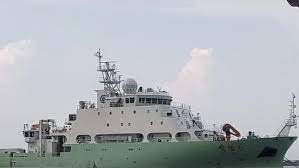The Sri Lankan government’s decision on whether to permit the Chinese research vessel Shi Yan 6 to dock at the Colombo port in October remains uncertain, as it grapples with diplomatic intricacies involving Indian security concerns. The vessel’s current location in the mid-ocean, en route to Sri Lanka, has raised questions about the delicate balancing act Sri Lanka faces in the Indian Ocean region.
Mixed Signals from Sri Lanka: The Ranil Wickremesinghe-led government has been sending mixed signals regarding the docking permission for the Chinese vessel. Sri Lankan Foreign Minister Ali Sabry recently stated that Colombo had not granted permission due to Indian security concerns. However, Sabry also mentioned that negotiations were ongoing, and if the vessel adhered to Sri Lanka’s standard operating procedures (SOPs), there might be no obstacles.
President Wickremesinghe had previously asserted that there were no Chinese spy ships in Sri Lanka and that docking permission would be granted if the vessel followed Sri Lanka’s SOPs. The Shi Yan 6 is scheduled to conduct joint military scientific research in Sri Lanka’s Exclusive Economic Zone (EEZ) and beyond in October-November 2023.
Chinese Research Vessel Activity in the Indian Ocean: Since 2019, a total of 48 Chinese scientific research vessels have been deployed in the Indian Ocean Region (IOR), primarily in the Bay of Bengal, south of the Arabian Sea, and towards the Persian Gulf. This increased presence has raised concerns among neighboring countries, particularly India.
Economic Ties and the Belt and Road Initiative (BRI): India is closely monitoring Sri Lanka’s decision on permitting the Shi Yan 6 to dock in Colombo, with the expectation that a final decision will be made during President Wickremesinghe’s visit to Beijing in October for the 10th-anniversary celebration of the Belt and Road Initiative (BRI).
Sri Lanka’s economic challenges, exacerbated by high-interest loans and infrastructure projects funded by the Chinese EXIM bank under the BRI, have deepened over the years. The Hambantota seaport was leased to China for 99 years during Wickremesinghe’s tenure as a Cabinet Minister and Prime Minister, as Sri Lanka struggled to repay loans.
Vessel’s Recent Movements: The Chinese research vessel Shi Yan 6 entered the Indian Ocean via the Malacca Straits on September 23, and it was observed in Singapore on September 14. It left its homeport, Guangzhou, on September 10.
Geopolitical Tensions in the Region: While India has emphasized Sri Lanka’s need to address its security and strategic concerns, China’s influence in Sri Lanka has grown through mounting debt and intelligence penetration. Sri Lanka may choose to delay granting permission for the research vessel’s docking, possibly hoping that the November turbulence in the Indian Ocean will impact the situation.
News Summary:
- Sri Lanka’s decision on whether to allow the Chinese research vessel Shi Yan 6 to dock in Colombo in October is uncertain, with diplomatic complexities related to Indian security concerns.
- Sri Lankan Foreign Minister Ali Sabry stated that permission had not been granted due to Indian security concerns but suggested negotiations were ongoing.
- President Ranil Wickremesinghe previously indicated that docking permission would be granted if the vessel followed Sri Lanka’s standard operating procedures.
- China has deployed 48 scientific research vessels in the Indian Ocean Region since 2019, causing concerns among neighboring countries.
- India is closely monitoring the situation, expecting a decision during President Wickremesinghe’s visit to Beijing for the Belt and Road Initiative celebration in October.
- Sri Lanka’s economic challenges, tied to the Belt and Road Initiative, have deepened over the years.
- The Chinese research vessel Shi Yan 6 entered the Indian Ocean recently, following a route that has raised questions about Sri Lanka’s decision-making.
- Tensions between India and China in the Indian Ocean region continue to be a geopolitical concern.

Leave a Reply